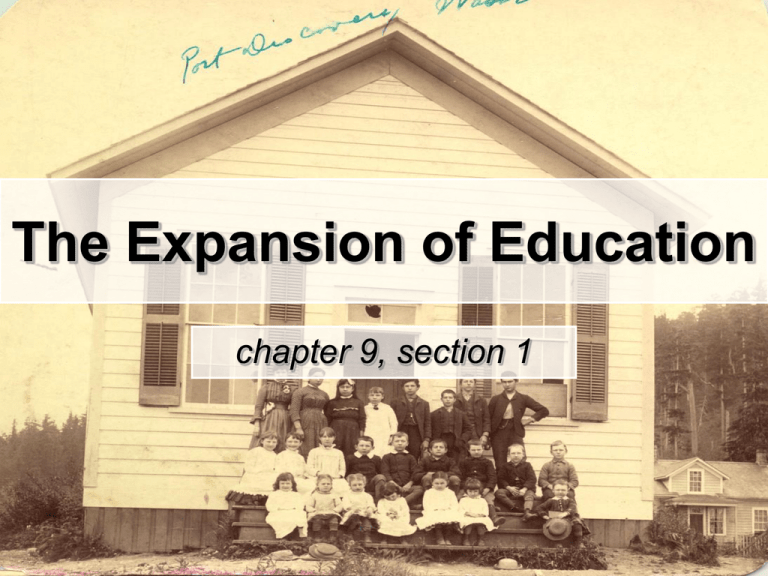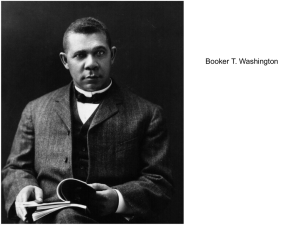The Expansion of Education - Humble Independent School District
advertisement

The Expansion of Education chapter 9, section 1 Growth of Public Schools • Importance of literacy (1st step toward success) • 1870s –Leaving school at an early age –2% of 17-year-olds graduated HS –Rural: November to April only Growth of Public Schools • Industry grows after Civil War –People move to cities –Emphasis on education • By 1910, graduation rate = 8.6% (This is up from 2% in 1870s.) School Days • One-room school houses –Ages 6 to 14 years old –1 teacher (older students taught younger) –Mostly rote memorization (reading aloud & repeating) –Subjects (geography, history, R, R, R) Immigrants • Assimilation for children –English literacy –American cultural values (thrift, patriotism, & hard work) –Traditional American cooking –Traditional American games • Some resisted (Catholic school) Uneven Support • Separate schools for whites and blacks – Minority schools received less money • Virtually no schooling for Native Americans. Those that attended: – Gave up their language – Gave up their dress – Gave up their customs/culture Higher Education • 1880-1900 150 new colleges/universities open • Wealthy contributions to education – Stanford – Rockefeller • Enrollment doubles (1890-1910) – Soon middle-income families send kids Women & Higher Ed. • Private women’s colleges established by philanthropists • 1880/90s: pressure to admit women – Some, yes; others, no. • Most scholarships went to men. • Social prejudice against women – Too independent “unmarriageable” African Americans • Many wanted to enroll, but few schools allowed it. • Total enrollment (1890) = 160 • Most were at African American colleges (established during Reconstruction) – By 1900, there were 2,000 graduates. Black Education Opinions • 2 famous African American college graduates: –Booker T. Washington –W.E.B. Du Bois • 2 very different perspectives Booker T. Washington “To those of my race who depend on bettering their condition… I would say: ‘Cast down your bucket where you are’ …No race can prosper till it learns that there is as much dignity in tilling a field as in writing a poem” Booker T. Washington • Founded Tuskegee Institute (Alabama, 1881) • Focus: – Building economic security & vocational skills – Not on political equality • Popular w/ whites W.E.B. Du Bois “I insist that the true object of all true education is not to make men carpenters, it is to make carpenters men….” W.E.B. Du Bois “…The Talented Tenth of the Negro race must be made leaders of thought and missionaries of culture among their people. No others can do this work and Negro colleges must train men for it.” W.E.B. Du Bois • Harvard PhD • The Talented Tenth • Political/social equality & civil rights • Liberal arts (not vocational) • Pride in heritage • Niagara Movement (1905) Niagara Movement • Met on Canadian side of Niagara Falls • Called for: –Full civil rights –End to racial discrimination –Recognition of human brotherhood • Led to the formation of NAACP New Entertainment chapter 9, section 2 Flowchart Industrialization Urbanization New Commercial Recreation Industry Vaudeville / Minstrel Show • Vaudeville –Inexpensive variety show –Comic sketches (racial/ethnic humor), song/dance, magic acts • Minstrel Shows –Blackface (perpetuation of black stereotypes) Movies •1908 –8,000 nickelodeons (theaters set up in converted stores or warehouses that charged a nickel for admission) –200,000 viewers daily •Movies continue to get bigger and better Circus •1872 –The circus train: traveling circus –“Advance men” promote the show days in advance, drawing in huge crowds. –Running away to join the circus Amusement Parks •Advances in trolley technology –Trolleys extended to lesser populated areas –“Trolley Parks” at the end of the line •½ day off on Saturdays (more common) •Music, games of skill, rides, beaches, vaudeville Sports •Baseball –By far the most popular –Development of leagues –1869 Cincinnati Red Stockings (first professional team) Sports •Football (1880s) –Walter Camp began adapting rugby •Basketball (1891) –Invented by Dr. James Naismith, a PE teacher in Springfield, Mass. •Women –Played, but not equally encouraged Reading •Newspapers –Easier printing mass production –Now w/comics, sports, pictures, etc. –Circulation rises from 2.6 million1870 to 15.1 million1900 –Becomes big business more competition sales tactics change Reading •Yellow Journalism –sensational mass coverage (murders, vice, scandals, etc.) –Reference to yellow ink in a popular comic strip of the era Reading •Magazines •Popular Fiction –Dime novels –Social protest novels –Humorous novels Music •Negro Spiritual –African American folk music –Acceptable to whites •Ragtime/Jazz (New Orleans) •Music @ home –Player piano, phonograph






